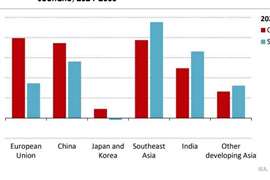Read this article in Français Deutsch Italiano Português Español
U.S. natural gas and LNG exports rise as oil prices soften
November 12, 2025
EIA forecasts tighter gas balance and higher LNG shipments through 2026

Global oil markets are expected to ease in 2026, but the U.S. natural gas sector continues to tighten as liquefied natural gas (LNG) exports expand and domestic production growth slows, according to the U.S. Energy Information Administration’s (EIA) latest Short-Term Energy Outlook.
The EIA projects Henry Hub natural gas prices will average about $4.00 per million British thermal units (MMBtu) in 2026, up 16% from this year, reflecting stronger LNG exports and steady winter heating demand. In contrast, global oil inventories are rising, putting downward pressure on crude prices even as gas markets strengthen.
Gas prices firm as exports expand
The EIA expects Henry Hub spot prices to rise to an average of $3.90/MMBtu this winter (November–March), following typical seasonal patterns of higher heating demand. Prices are then forecast to hold near $4.00/MMBtu in 2026 as U.S. LNG exports continue to grow and domestic production levels off.
“Flat production and strong export growth are expected to tighten natural gas balances,” the agency said.
U.S. LNG terminals are exporting gas at record levels. The EIA expects average LNG exports of 14.9 billion cubic feet per day (Bcf/d) in 2025, up 25% from last year, driven largely by rapid commissioning of the Plaquemines LNG facility in Louisiana. That project has come online faster than expected, prompting the EIA to raise its fourth-quarter export forecast by 3% from the prior month.
Exports are projected to increase another 10% in 2026, underscoring the U.S. role as the world’s leading LNG supplier.
In contrast to the tightening gas market, the EIA expects global oil inventories to build through 2026, exerting downward pressure on crude prices. Brent crude is forecast to average $54 per barrel in the first quarter of 2026 and $55 per barrel for the year, about $3 higher than last month’s forecast due to revised assumptions about Chinese stockpiling and ongoing Russian sanctions.
Lower crude prices will filter through to the retail level, with U.S. gasoline prices projected to fall below $3.00 per gallon in 2026 and diesel prices averaging $3.50 per gallon, both declines from 2024 levels.
While oil prices ease, electricity demand continues to grow—particularly in Texas and neighboring states. The EIA expects U.S. electricity sales to rise 2.4% in 2025 and 2.6% in 2026, led by demand from data centers and cryptocurrency mining facilities in the West South Central region.
Coal production, meanwhile, is forecast to remain steady above 500 million short tons (MMst) in 2026, buoyed by the reopening of several Appalachian mines and slower stock drawdowns at coal-fired power plants.
Outlook
The EIA’s forecast highlights diverging trends across the U.S. energy landscape. Oil and refined fuel prices are poised to soften amid growing inventories, but natural gas remains on a firmer trajectory as export capacity expands and new LNG projects ramp up.
By late 2026, the United States is expected to solidify its position as the world’s largest LNG exporter, even as domestic producers face limited output growth and infrastructure planners balance expanding export demand with system reliability.
MAGAZINE
NEWSLETTER

CONNECT WITH THE TEAM









